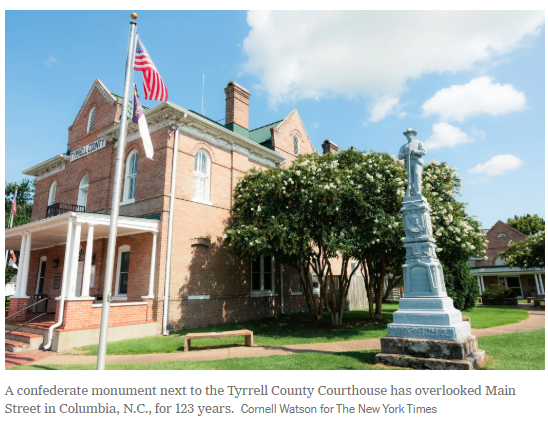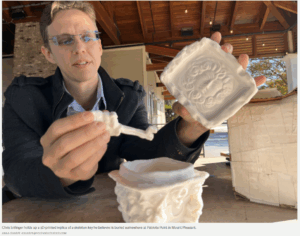NORTH CAROLINA: North Carolina Confederate Monument Goes Too Far, Lawsuit Says
A long battle over the pro-slavery words on a Tyrrell County statue intensifies as the Trump administration reclaims Confederate imagery.
The first time Sherryreed Robinson remembers noticing the words — “IN APPRECIATION OF OUR FAITHFUL SLAVES” — etched on a Confederate monument in Columbia, N.C., she was a teenager performing with her high school band on the steps of the Tyrrell County courthouse. She remembers approaching the 23-foot Confederate soldier statue and focusing on those six words.
For Ms. Robinson, a high school junior at the time, “faithful” and “slaves” did not feel right together.
About three decades later, with the 123-year-old monument still overlooking the historic town’s Main Street, she joined a federal lawsuit calling for the “faithful slaves” inscription to be removed or covered. It is believed to be the only courthouse monument in the country to “textually express” such a message, according to the lawsuit.
“I just remember thinking that slaves had to be so-called faithful or they would be punished or even worse,” Ms. Robinson, 50, said. “As an adult, the words sitting on the grounds of a courthouse made me question whether Blacks could really receive justice there.”
Earlier this year, a federal judge allowed a portion of the 2024 lawsuit to move forward. County officials have long contended that a state monument protection law restricts them from moving the statue or making changes to it.
Image

The Columbia case is unfolding amid a reverse reckoning of sorts, as the Trump administration reclaims Confederate iconography, part of a sweeping mission to shift or reframe how American history is presented.
In June, President Trump directed the military to restore Confederate names that had been removed from military bases, but drawing from other people with similar names or initials. In early August, the National Park Service announced plans to restore a statue of Albert Pike, a Confederate general and diplomat, and return it to a public square near the Capitol grounds. The 11-foot statue was toppled and set on fire by demonstrators during 2020 Black Lives Matter protests in Washington. And Defense Secretary Pete Hegseth ordered a Confederate sculpture that had been removed from Arlington National Cemetery in Virginia in 2023 to be reinstalled.
Last year, Concerned Citizens of Tyrrell County, a civic group made up of mostly older Black residents, filed a lawsuit in the U.S. District Court for the Eastern District of North Carolina against the county.
The suit argued that the “faithful slave” message constitutes racially discriminatory government speech, violating the 14th Amendment’s equal protection clause, and called for the county to remove or cover the message.
David Clegg, the county manager and attorney, declined to comment beyond the legal pleadings. In a motion to dismiss the lawsuit, filed in October 2024, the defendants argued the body has legislative immunity and that they are bound by a 2015 North Carolina monument protection law that limits when an “object of remembrance” on public property can be moved or altered.
Image

“The North Carolina Court of Appeals has ruled that county commissioners are bound by this statute, and that commissioners who are bound by this statute are not motivated by a discriminatory intent,” it reads. “Tyrrell County should not be subject to liability based on its decision to follow state law.”
With 160 years having passed since the end of the Civil War, Confederate symbols — mounted on courthouse lawns, towering over town squares, affixed to schools and streets and parks — are celebrated, contested and used as a lens on American history and race relations. Critics consider Confederate imagery racist, an offensive tribute to the Lost Cause. Supporters contend that they are a way to honor the sacrifices of soldiers who fought in the war.Today, the national landscape is still dotted with more than 2,000 Confederate symbols in public spaces, according to the Southern Poverty Law Center, a legal advocacy group.
“This is about history and memory and power,” said Rivka Maizlish, a senior research analyst with the center who focuses on tracking the symbols. “These debates over Confederate memorials are about resisting a propaganda campaign to erase the memory of the true meaning of the Civil War, which was a struggle between slavery and freedom.”
The fight in Tyrrell County mirrors other places, mostly small Southern towns and rural communities, where neighbors sometimes take opposing sides over how slavery and the Civil War should be memorialized. About 30 miles away, the town of Edenton has also been embroiled in a legal battle over moving its Confederate monument from a waterfront location. But the example most similar to the one in Columbia includes the phrase “faithful slaves” and stands in Confederate Park in Fort Mill, S.C.
Along the Main Street in Columbia — a riverfront town about 150 miles east of Raleigh — few people were willing to speak publicly about the monument and the lawsuit.
Image

But a community Facebook page offered a glimpse into how some Tyrrell County residents and others felt. Some were embarrassed by the “faithful slave” language, describing it as a relic of an ugly past. Others felt moving or altering the monument was effectively erasing history. They saw the statue as a way to honor soldiers and said that their Southern pride and heritage were being unfairly attacked.
The statue has stood near the entrance of the courthouse since 1902, part of a wave of Confederate monuments erected during the Jim Crow era, beginning in the late 1800s. It was a gift from the Tyrrell Monument Association, an organization founded by William Fessenden Beasley, a former lieutenant colonel in the Confederate Army, according to the lawsuit. The monument consists of a Confederate soldier standing atop a base featuring a bust of Gen. Robert E. Lee. One of the statue’s panels includes the “faithful slave” inscription.
Mark Snell Brickhouse’s great-great-grandfather’s name is among those etched on the monument. He returns to Columbia regularly to visit a family cemetery and the monument.
“I love the statue because it honors my family members,” said Mr. Brickhouse, 72. “But I can see how the words are offensive to some people. I think the statue should stay because it reflects our history, but those words should be covered.”
Image

Since the 1990s, Concerned Citizens of Tyrrell County has pushed to have the statue moved off the courthouse grounds. Recently, they began to focus on removing the inscription, seeing it as an easier task, but also so the next generation of students doesn’t have to see the words.
Over the years, the group held public marches and demonstrations, spoke at commission meetings and mounted billboards.
“The statue has been here all of my life, but I had no idea the message about faithful slaves was there,” said Joyce Sykes Fitch, a plaintiff in the case who traces her family lineage in the area to before the Civil War. “It was not until I moved back to North Carolina in 2017 after I retired and decided to get involved in the community that I discovered what it said. It’s still hard to believe those words are there.”
The lawsuit describes the plaintiffs as part of a small Black population of less than 1,000 residents in Tyrrell County — about one-third of the total — who are “direct descendants of people whom the county, by way of the ‘faithful slaves’ message, is talking about.”
“This is the only monument of its kind at a courthouse with that language of appreciation, or an endorsement, of slavery on it,” said Ian Mance, a lawyer of Emancipate NC, a racial justice advocacy and litigation organization. “You are talking about families who have been here since before the Civil War. For them, there is this feeling that this monument is offering commentary about their families.”
Mr. Mance said the suit was not seeking damages. “Our contention is that equal protection does not allow the government itself to actually make racially discriminatory statements,” he said. “By the statue being on government property, it represents government speech.”
–nytimes.com



